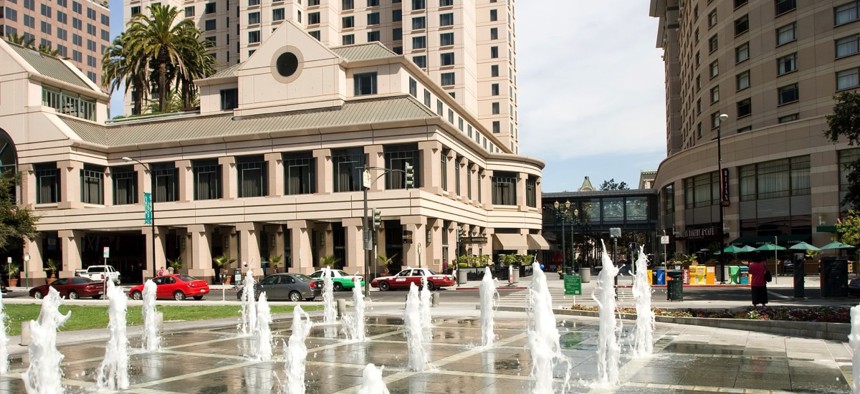Making Community Wireless Networks Part of the Internet Solution

San Jose's downtown business district has been blanketed with free, public Wi-Fi. Mariusz S. Jurgielewicz / Shutterstock.com
A new report shows how community Wi-Fi projects can be effective, successful and sustainable investments for cities as part of their 21st century strategies.
For millions of Americans, access to fast, affordable and reliable Internet service is vital for their lives and economic well-being. City leaders—recognizing the opportunity to better serve their residents—are now working to help citizens achieve the potential of high-quality Internet. And in many cities, community Wi-Fi networks have played an important role in this larger goal by ensuring connectivity in public spaces.
Just last month, I had the opportunity to moderate a panel of city officials at the Gigabit Cities Live conference in Atlanta and was able to hear real lessons from leaders who have implemented community wireless projects in their cities. These panelists talked about benefits such as how their community wireless networks promote growth in business districts, bridge the digital divide and enable digital sensor capabilities for smarter cities.
Many of these lessons are also laid out in a recent report from Freedman Consulting, LLC, that highlights the role of municipal Wi-Fi networks in achieving smarter, more responsive and more vibrant communities. The report, “Toward an Understanding of Best Practices in Community Wireless Networks: A Survey of Select Networks,” was supported by the Ford Foundation and highlights 11 diverse cities and shows how these communities are using wireless networks to strengthen business districts, increase Internet access for communities that wouldn’t otherwise have it and improve services for smarter city government.
When many “techies” think about municipal wireless projects, the first thing that comes to mind is often the failures and unfulfilled promises of the early 2000s. Yet, as this new report shows, community wireless networks are reemerging as an effective, successful and sustainable investment for cities around the country as part of their 21st century strategies.
As a former educator and community advocate, I know firsthand how important it can be for communities to tackle the digital divide and provide Internet access to those who may not otherwise have it. That’s why I lead Next Century Cities, a city-to-city collaborative of nearly 90 communities across the country whose leaders seek to ensure that all of their residents have access to fast, affordable and reliable Internet. The communities that make up Next Century Cities have incredible, diverse approaches to ensuring access to high-quality Internet from municipally-owned networks to public-private partnerships.
This new community wireless report and the recent panel held at Gigabit Cities Live explored the potential for using community wireless networks to creatively solve problems facing municipalities and bridge the digital divide.
For example, the new report shows how in Minneapolis, Minnesota, the city has been able to use a public-private partnership to implement a community wireless network covering the entire city—giving citizens with limited financial resources access to the Internet. In addition to enabling low-cost subscription Internet at $19.95 per month, Minneapolis and its partner company have worked to provide free wireless Internet in some parts of the city, increase digital literacy and ensure that residents understand the value of digital connectedness through a digital inclusion fund.
Another model can be seen in San Jose, California, where city officials have worked to blanket the downtown business district with free, wireless Internet available to business owners, residents and visitors. The network has given reliable Internet access to 50,000 people in a 1.5-square-mile downtown area, in addition to the airport and convention center. The free community network has helped to draw visitors to the downtown area, provided access at places like the airport (with speeds rivaling home connections) and helped to create a vibrant business district in San Jose.
A final demonstration of how community wireless can benefit cities can be seen in Corpus Christi, Texas, where the city has deployed a municipal wireless network that aids government and builds smarter infrastructure. The new report details how Corpus Christi developed a community wireless network in 2002 to enable automated, electronic data collection of gas and water usage—saving the city an estimated $1.5 million per year and allowing for better tracking of use to adjust production. Additionally, in a city that has seen its fair share of severe weather such as hurricanes, the network provides a reliable backup communications infrastructure that can help both first responders and community members stay connected.
The impacts of community Wi-Fi in these cities and others around the nation are impressive and show the exciting role this innovation can play in achieving healthier, smarter and more resilient communities. As technology continues to advance and costs continue to decrease, now is the time for communities across the country to embrace and harness these networks to provide reliable service and much-needed Internet access for so many more Americans.
EARLIER on Route Fifty: How Digital Equity Is a Driving Force for Some Gigabit Cities
Deb Socia is the Executive Director of Next Century Cities, an effort that supports community leaders who seek to ensure that all have access to fast, affordable and reliable Internet.

NEXT STORY: DARPA’s games help engineers work out coding kinks





